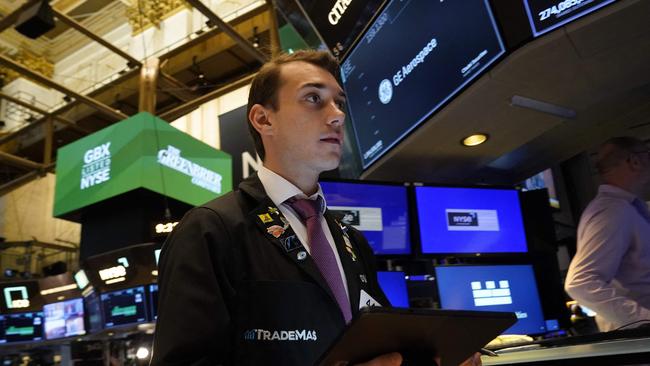Recession rule ‘triggered’ in softer than expected US jobs numbers
New US jobs data has just dropped and it’s not great reading with a key indicator of a recession being imminent.
Economy
Don't miss out on the headlines from Economy. Followed categories will be added to My News.
Disappointing new jobs figures released in the US economic data has set off a key “trigger” indicating a possible recession.
If the US falls into recession, Australia is poised to follow.
However, economists are being cautious about the fresh data. While they concede it is a concern, a downturn is not inevitable.
Figures released on Friday showed the jobs market of the world’s largest economy cooled much more than expected in July with unemployment reaching its highest rate since 2021, fuelling calls for interest rate cuts as high levels bite.
In July 114,000 jobs were added, down from June’s revised 179,000 figure, said the US Department of Labor.
The jobless rate rose to 4.3 per cent, the highest since October 2021, according to government data.
Wall Street stocks slid further into the red on Friday with the tech-heavy Nasdaq index dropping as much as three per cent after the employment report.
It’s now down more than 10 per cent from an early July high.

“Today’s report shows employment is growing more gradually at a time when inflation has declined significantly,” said President Joe Biden in a statement.
But former president Donald Trump’s campaign took aim at elevated costs of living and the rise in unemployment as he seeks another White House term, saying “America’s working families are hurting.”
The report brings the Federal Reserve closer to its first rate cut after the pandemic – with inflation moving towards officials’ two per cent target.
But some economists caution the central bank may have to take stronger policy action in the coming months including interest rate cuts.

Sahm rule triggered
Elizabeth Crofoot, a senior economist at labour analytics firm Lightcast, told CNN that the unemployment increase had triggered the “Sahm rule,” an indicator that a recession is imminent or underway.
The rule states a downturn is happening if the unemployment rate rises by 0.5 percentage points or more above its prior 12-month low.
A year ago the US unemployment average was 3.6 per cent, so 4.3 per cent, July’s figure, is 0.7 basis points above that.
The rule is from noted economist Claudia Sahm who it’s said has correctly predicted every US recession since the 1970s.
Higher unemployment in the US’ very flexible labour market means more lay-offs – many with no redundancies – and that leads to pared back spending which then leads to be more lay-offs.

‘Hesitant to use the R word’
However, economists have said the pandemic has thrown previous recession indicators into flux.
Oxford Economics chief US economist Ryan Sweet cautioned that “this cycle is unique.” In recent times, the reason unemployment has edged is less to do with lay-offs and more to do with people entering the labour force either through immigration or returning after a pandemic gap.
This marks less of a risk that a vicious cycle of rising jobless rates leads to income loss — and further employment cuts, he told AFP.
Ms Crofoot held a similar view: “I’m very hesitant to use the ‘R’ word, because I don’t think we’re there; but this is something to keep our eye on”.
For instance, during the second quarter in the US the economy grew by 2.8 per cent.
The stock market sell off is also bing called a “correction” after record highs.

Weak ‘across the board’
“Job growth was weak across the board, with small gains or losses across the economy,” said Mortgage Bankers Association chief economist Mike Fratantoni.
He added that the slowing in the market was consistent with trends elsewhere such as increases in initial claims for unemployment insurance and signs of contraction in manufacturing.
“Employment continued to trend up in health care, in construction, and in transportation and warehousing, while information lost jobs,” said the Labor Department.
Government employment, which slowed in recent months, was little changed in July.
“There are signs that momentum is waning,” said KPMG chief economist Diane Swonk about public sector hiring in a recent note.

More aggressive cuts?
Senator Elizabeth Warren, a leading progressive, said Federal Reserve Chair Jerome Powell “made a serious mistake not cutting interest rates” in the central bank’s most recent meeting.
“The jobs data is flashing red,” she added in a social media post.
Nationwide chief economist Kathy Bostjancic warned the July report’s “across-the-board weakness” feeds the view that the Fed is late to easing monetary policy.
“The bond market is pricing in much more aggressive rate cuts” of at least 100 basis points by year-end, she added in a note.
Sweet told AFP that a 25 basis points cut in September “is essentially a done deal,” with chances shifting toward three instead of two cuts this year.
Mr Powell this week had “downplayed the potential” for a 50 basis point cut in September, Sweet said, unless labour market data continues to soften.
But economists Carl Weinberg and Rubeela Farooqi of High Frequency Economics said in a note that even as unemployment remains historically low, “further decay will trigger alarms at the Fed about its second mandate.”
They are referring to the central bank’s dual mandate of price stability and maximum employment.
Originally published as Recession rule ‘triggered’ in softer than expected US jobs numbers




